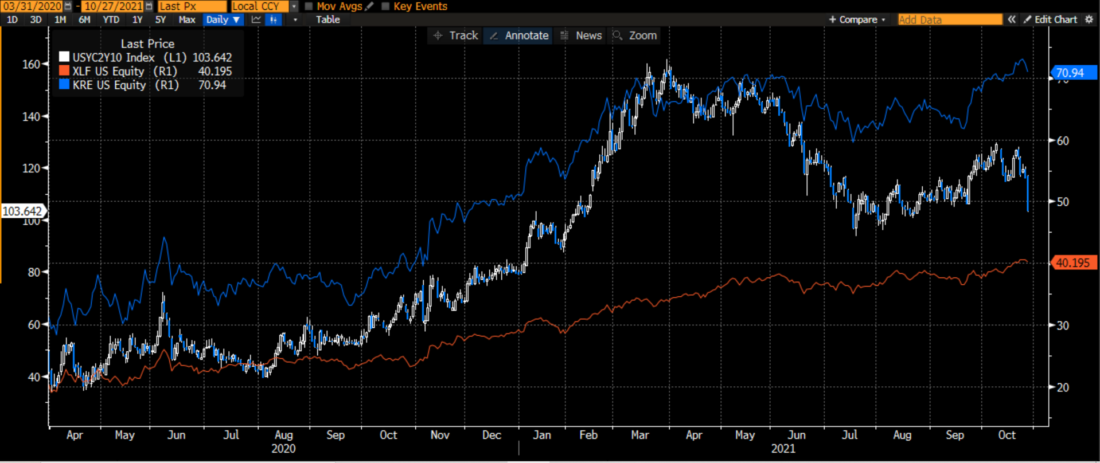Traders and investors are always searching for defined relationships. It makes life much easier if we can say that product X went up because of a change in Y, and it makes trading much more profitable if that relationship is statistically significant. An obvious example would be when energy stocks rise or fall when they follow changes in the price of crude oil. Investment theses and statistical arbitrage funds are built around this premise.
One of the more logical relationships is between bank stocks and the steepness of the treasury yield curve. A bank’s main input and output is money. Banks tend to borrow short-term, via deposits, commercial paper, and the like, and lend long-term via commercial loans and mortgages. If the yield curve is positively sloping, meaning that longer-term rates are higher than short-term rates, then the input cost to the bank is less than its output. The steeper the yield curve, the greater the differential between a bank’s borrowing costs and lending revenues, the greater the profit that flows to the bank’s bottom line.
One common proxy for the steepness of the yield curve is the spread between 2 and 10-year treasury notes. As a result, it has been quite common for increases in that spread to be used as a rationale for buying XLF, the Financial Select Sector SPDR that has become a proxy for large banks and financial institutions. In many ways that is an imperfect proxy, since XLF contains many important non-bank financial companies and banks with large trading and custody operations.[i] KRE, the SPDR Regional Banking ETF is a more pure play on institutions that rely mostly on basic borrowing and lending activities, thus exposing them more to the shape of the yield curve.
We can see the relationships in the graph below, which shows the movements in XLF and KRE plotted against the 2-10 yield spread:
XLF (red line), KRE (blue line), vs 2-10 Yield Curve (white/blue bars) since March 2020

Source: Bloomberg
We see that while both XLF and KRE generally kept pace with the steepening yield curve since the Fed began aggressive monetary accommodation in the wake of the Covid crisis, KRE was more closely tied to that yield spread. The following graph shows the excellent correlation between KRE and the yield spread:
One Year Linear Regression, 2-10 Yield Spread (X-axis) vs. KRE (Y-axis)

Source: Bloomberg
We see a tight relationship between the two, with an R-squared of .765. That can be considered a reasonable cause and effect from a trader’s viewpoint. But in both cases, the bull market in stocks can’t be discounted. The ETFs rose markedly when the yield curve steepened in the first quarter of 2021, but haven’t given back most of those gains even when the curve flattened over the summer.
Today, when we see a marked flattening of the 2-10 spread – nearly 10 basis points – the 1% fall in XLF and 2% fall in KRE seem understated. We see it at the tail of the first graph, and in the high level of the red star in the second. It is even clearer in a 6 month version of the first graph (below). If one has been trading this relationship, the bullish environment has been a definite boon if one is long KRE or XLF today. That said, if the relationship holds tightly, those ETFs could see some further declines if the yield curve maintains its current shape.
XLF (red line), KRE (blue line), vs 2-10 Yield Curve (white/blue bars) past 6 Months

Source: Bloomberg
—
[i] The largest component of XLF is Berkshire Hathaway (BRK.B), which is organized as an insurance company despite being well-known as the vehicle Warren Buffett’s investments.
Disclosure: Interactive Brokers
The analysis in this material is provided for information only and is not and should not be construed as an offer to sell or the solicitation of an offer to buy any security. To the extent that this material discusses general market activity, industry or sector trends or other broad-based economic or political conditions, it should not be construed as research or investment advice. To the extent that it includes references to specific securities, commodities, currencies, or other instruments, those references do not constitute a recommendation by IBKR to buy, sell or hold such investments. This material does not and is not intended to take into account the particular financial conditions, investment objectives or requirements of individual customers. Before acting on this material, you should consider whether it is suitable for your particular circumstances and, as necessary, seek professional advice.
The views and opinions expressed herein are those of the author and do not necessarily reflect the views of Interactive Brokers, its affiliates, or its employees.




















